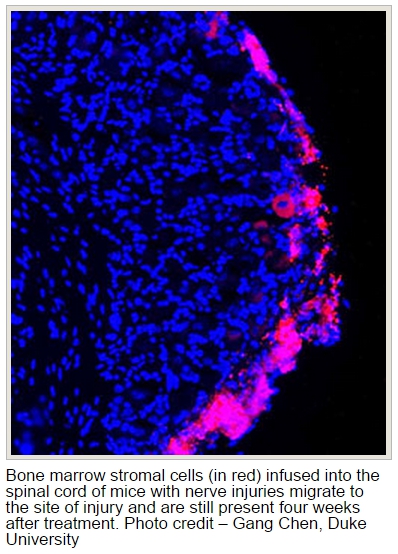But in a study on mice, a Duke University team has shown that injections of stem cells from bone marrow might be able to relieve this type of neuropathic pain. The researchers say their findings, which appear July 13 in the Journal of Clinical Investigation, may also advance

The team used a type of stem cell known as bone marrow stromal cells (BMSCs), which are known to produce an array of healing factors and can be coaxed into forming most other types of cells in the body.
Stromal cells are already being tested in
«Based on these new results, we have the
In his team’s study, the researchers used stromal cells to treat mice with pain caused by nerve damage. They delivered the cells by a lumbar puncture, infusing them into the fluid that bathes the spinal cord.
Mice treated with the bone marrow stromal cells were much less sensitive to painful stimuli after their nerve injury compared with the untreated mice, the researchers found.
«This analgesic effect was amazing," Ji said. «Normally, if you give an analgesic, you see pain relief for a few hours, at most a few days. But with bone marrow stem cells, after a single injection we saw pain relief over four to five weeks.»
Pictures of the animals’ spinal cords showed that the injected stem cells had set up shop alongside the nerve cells in the spinal cord.
To understand how the stem cells alleviated pain, the researchers measured levels of
TGF-β1 is a protein that is typically secreted by immune cells and is common throughout the body. Research has shown that people with chronic pain have too little TGF-β1, Ji said.
In the new study, chemically neutralizing TGF-β1 reversed the
By contrast, bone marrow stromal cells stay on site for as much as three months after the infusion, the scientists found. This is the right length of time, Ji said, because if the stem cells stayed permanently there could be risk of them becoming cancerous.
Importantly, BMSCs also migrate to the site of injury. That’s because a molecule emitted from the injured nerve cells called CXCL12 — which has also previously been linked to neuropathic pain — acts as a homing signal of sorts, attracting the stem cells.
The next step will be to find a way to make the stromal cells more efficient. «If we know TGF-β1 is important, we can find a way to produce more of it," Ji said. In addition, the cells may produce other
The study was supported by the National Institutes of Health (R01NS67686, R01NS87988, R01NS89479, R01DE17794, and R01 DE22743).
CITATION: «Intrathecal bone marrow stromal cells inhibit neuropathic pain via TGF-β secretion," Gang Chen,


